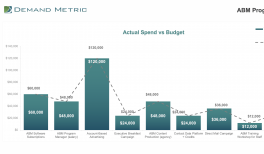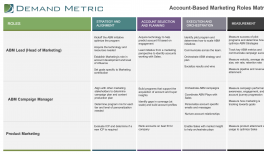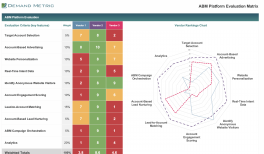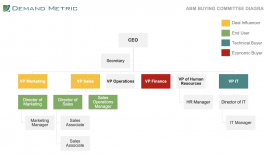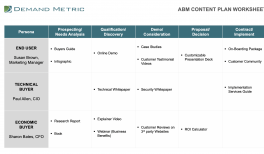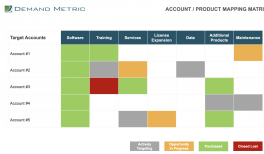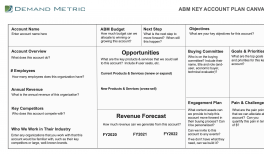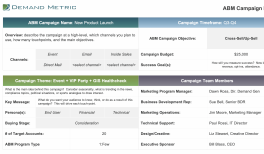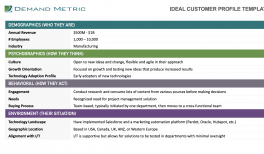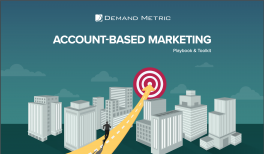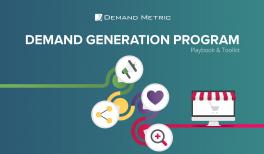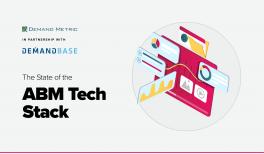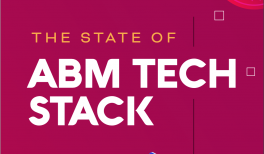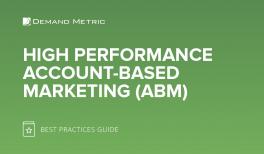Use our ABM Metrics Dashboard to define, track, and communicate your key ABM program metrics with your team.
ABM Metrics Dashboard
Resource Overview
Related Resources
Your Problem
You need to define, track, and report on your key account-based marketing (ABM) program metrics.
Our Solution
We created the ABM Program Metrics Dashboard template to help you define, track, and communicate your key ABM program metrics with your team.
The metrics in this template can easily be customized to suit your organization's needs. After selecting the ABM metrics that you want to track, populate the spreadsheet with your data.
Sample metrics used in this template include:
- Marketing Qualified Accounts (MQAs)
- Meetings Booked with Target Accounts
- Target Account Opportunities
- Target Accounts Won
- Target Accounts Expanded
- Annual Contract Value
Use the charts provided to share a visual representation of your key ABM metrics and the results of your program with the rest of your team.
Key Benefits
- increase the marketing team's credibility
- share your ABM program results
- leverage our pre-defined metrics
- gain support for budget approval
- save 4 hours on formatting
- provides a real-world example
Microsoft Excel Spreadsheet
Estimated Time Required: 4 Hours
Skills Required: Excel (Advanced)
Background
Measuring impact is critical to prove and improve the efficacy of an ABM strategy. Accurately measuring the impact of ABM requires a new set of metrics. Traditional marketing contribution models measure KPIs with defined targets for marketing 'sourced' or 'influenced' revenue. Still, the sales and marketing alignment inherent to effective ABM makes attribution models that separate sales and marketing revenue obsolete. Instead, gauge marketing's impact on an ABM strategy by identifying ABM-specific marketing metrics. Engagio(link is external) recommends metrics in each of the following areas:
- Coverage: Do you have sufficient data, contacts, and account plans for each target account?
- Awareness: Are the target accounts aware of your company and its solutions?
- Engagement: Are the right people at the account spending time with your company, and is that engagement going up over time?
- Reach: Are marketing programs reaching the target accounts? How much waste is there?
- Influence: How are the ABM activities improving sales outcomes such as deal velocity, win rates, average contract values, retention, and net promoter scores?
During the measurement phase, revisit the revenue, pipeline, and KPI goals set in the account planning phase and compare your goals to the campaign's outcome. Increasingly, marketing technology enables detailed marketing data analytics. The insights available through analytics technology are the essential final piece of the puzzle for any company that invests the resources in implementing a well-designed ABM strategy.
ABM measurement requires account-based metrics that are all about quality, not quantity. Traditional funnel metrics like marketing qualified leads will be less of a priority. As mentioned earlier, the role of the modern marketer requires a shift in mindset. Your role is no longer focused on generating 'hot' leads, but rather, influencing key buyers at best-fit accounts. This shift in measurement requires a new set of metrics with an account lens. Of course, you'll still want to look at campaign performance, revenue performance, and influence on the overall business. ABM doesn't change what you want to measure as much as how. You need to leverage an essential set of ABM metrics to get the insight necessary to improve your ABM campaigns and pipeline health.
For example, to measure campaign performance, look at specific metrics for account coverage, engagement, and penetration. A practical example helps illustrate how this is done. If you have a field marketing event specific to a set of target accounts in a particular region, you'll want to acquire attendees from those accounts and report on the event's account penetration and the overall engagement of an account, especially if the engagement comes from the key contacts at the account. Look at the impact this makes to your sales team just by applying account-based metrics to measure a program's success.
Sometimes the easiest way to see how ABM metrics matter is to compare the performance report of a traditional marketing program to that of an ABM program. Let's say you have a regional event that promotes best practices and educates your audience with thought leadership. If you're in the thick of traditional marketing tactics like lead generation, your performance report might result in a report that highlights a 40% attendance rate with 45/60 registrants scored and qualified as Marketing Qualified Leads (MQLs). You might, therefore, request that sales follow up with these leads you assigned to them. A sales team might review this list of MQL's and recognize that they are already talking to other individuals at those specific accounts who are more qualified. They might also reject those leads knowing that those accounts are not a good fit for your solution. There is little motivation for a sales representative to follow up with leads they know are either low-quality leads or come from low-quality accounts. It's easy to empathize with sales when you look at it from their perspective.
Imagine instead exchanging your traditional marketing metrics for ABM metrics. You have the same event with the same output of effort from marketing. The difference is only in the metrics. Your sales team learns that a regional field event resulted in a 75% target account penetration, five named target accounts attending, with 80% of attendees identified as part of the buying committee at those target accounts. Furthermore, three key individuals explicitly named in the after-event report were highly engaged at the event. Your Sales team will regard these marketing results as incredibly high value and influential since you've helped them keep their most important accounts engaged. In this ABM scenario, the sales team is highly motivated to call those individuals at the account.
Visit our Demand Generation & ABM Hub for other great resources.

